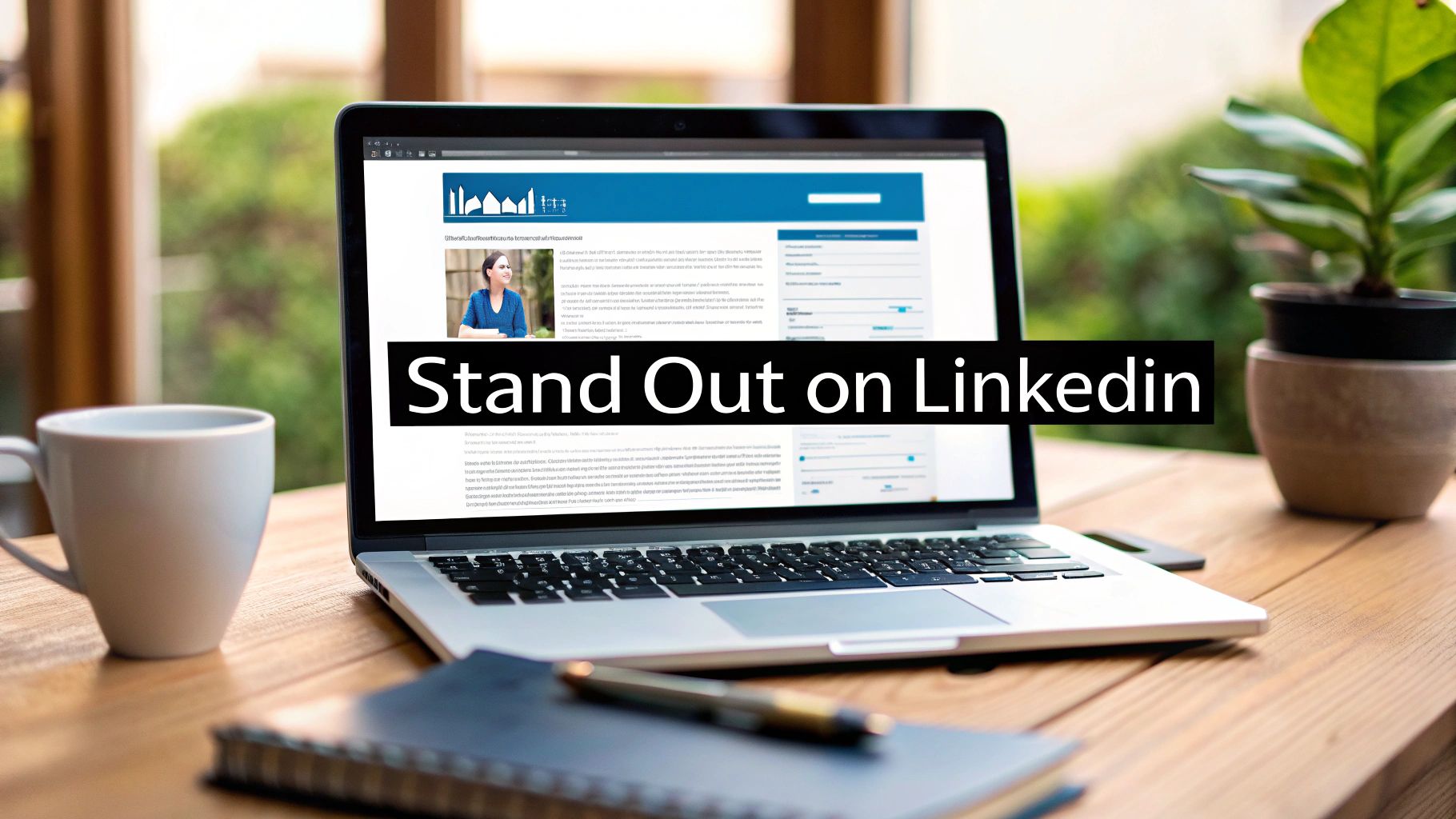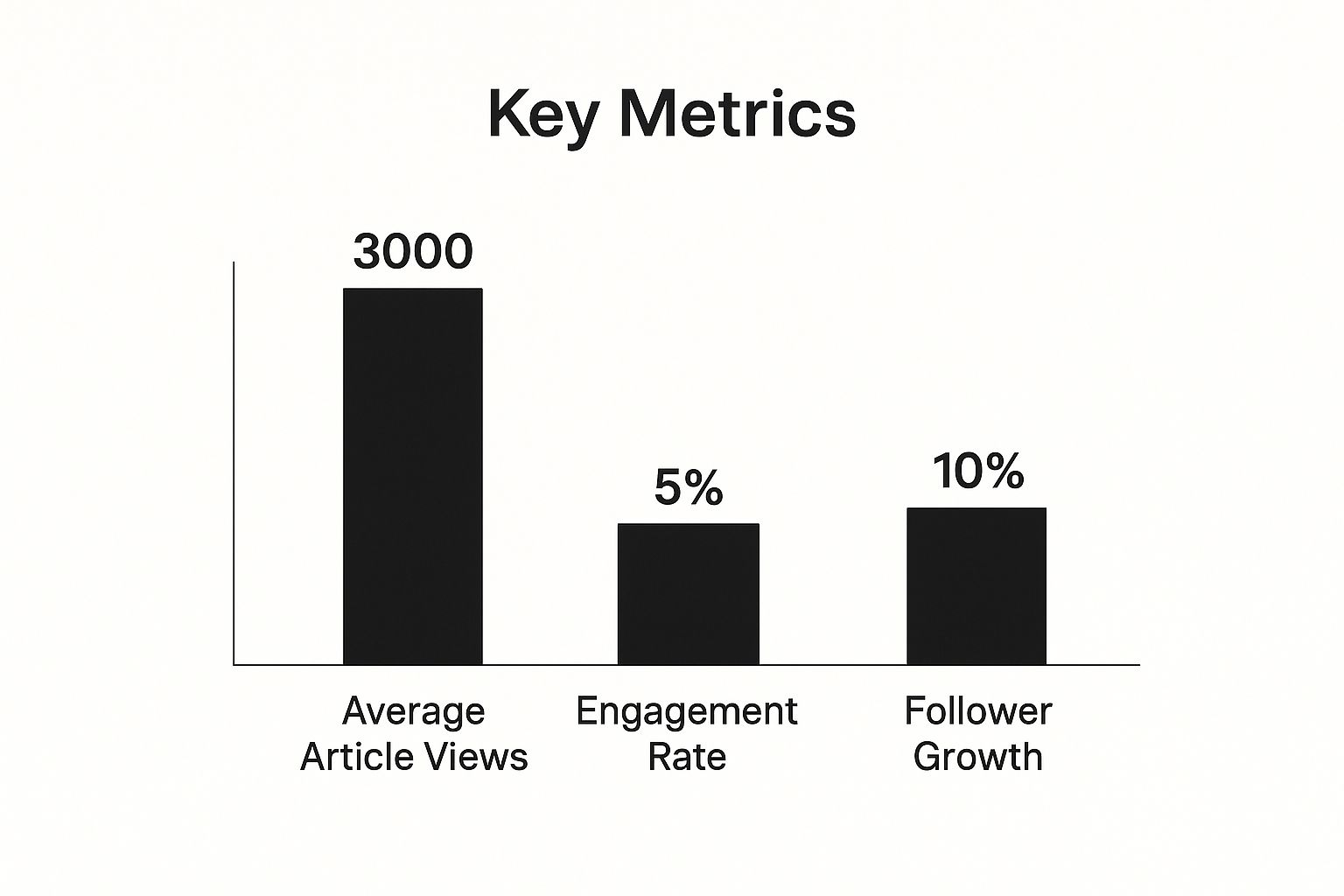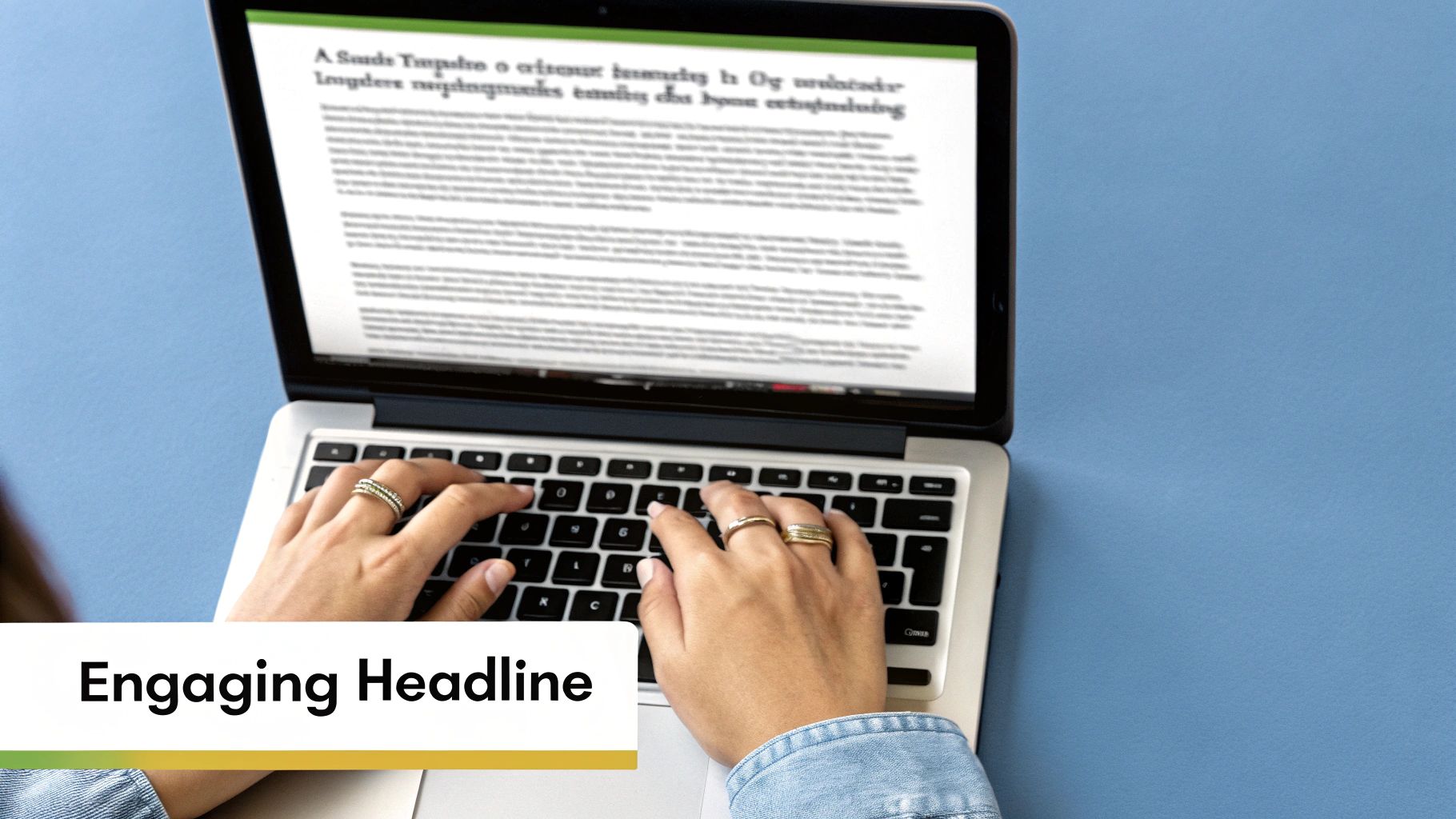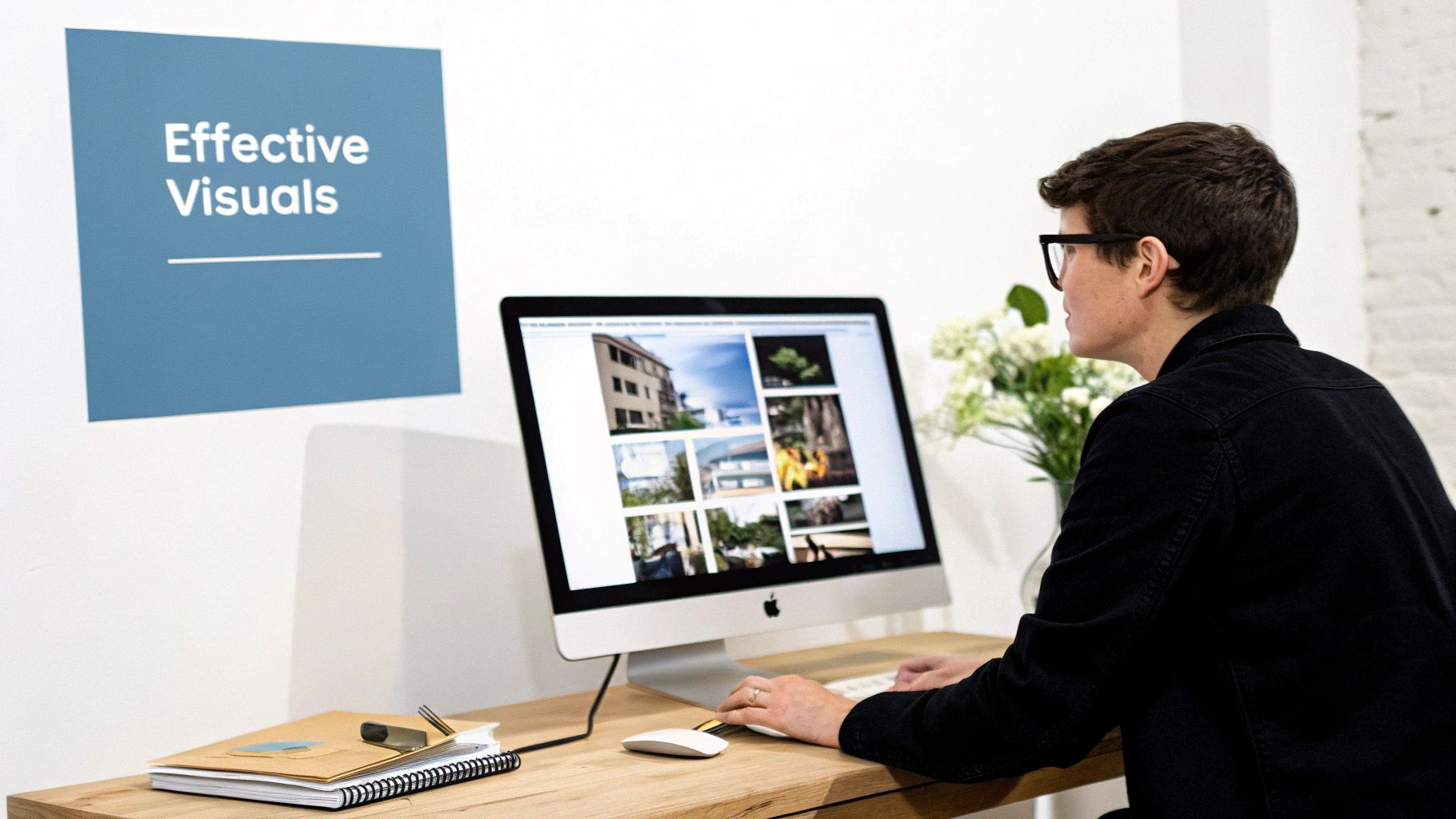
Write an Article on LinkedIn That Gets Noticed
Published on 2025-07-16
To really make an impact when you write an article on LinkedIn, you have to think differently. It's not just another social media post. It's your chance to lay out your expertise, build a compelling argument, and show you're a serious player in your field. Think of it as a detailed blog entry—complete with clear headings, short paragraphs, and a strong call-to-action—that solidifies your professional authority.
Why LinkedIn Articles Are Still a Power Play
In a world of endless scrolling and bite-sized updates, a well-crafted LinkedIn article is a genuine power move. It cuts through the noise. While a quick post is perfect for sharing a fleeting thought, an article gives you the space to unpack complex ideas, share detailed stories, and truly establish yourself as a go-to expert. You're not just chasing likes; you're building a lasting asset that showcases your deep knowledge.
Let's not forget who you're talking to. LinkedIn just blew past 1 billion users across the globe, and the audience is packed with decision-makers. A massive 47.3% of its users are Millennials, with another 28.7% from Gen Z. Plus, over half of all members come from households earning more than $100,000. These aren't just casual scrollers; they're potential clients, business partners, and employers hungry for valuable professional insights. If you're curious about the specifics, you can discover more about this high-value audience and what it means for your content strategy.
The Strategic Edge of In-Depth Content
While a standard post gets buried in the feed within hours, a LinkedIn article becomes a permanent part of your professional brand. It lives on your profile, always accessible from your "Activity" tab, and you can even pin it to your "Featured" section. This turns your profile into a living portfolio of your best thinking.
This image perfectly illustrates the kind of impact a good article can have, highlighting real gains in views, engagement, and even follower growth.

The numbers don't lie. Articles demand more effort upfront, but their power to drive meaningful conversations and expand your professional circle is undeniable.
The real power of a LinkedIn article isn't just in the views it gets on day one. It's in becoming a go-to resource that people discover weeks or even months later, cementing your reputation as an expert every time someone new finds it.
If you're weighing whether to write a full article or just a quick post, this quick comparison might help clarify the unique value each format brings to the table.
Strategic Value of LinkedIn Articles vs Posts
| Feature | LinkedIn Article | LinkedIn Post |
|---|---|---|
| Longevity | Permanent asset on your profile | Disappears in the feed quickly |
| Depth | Allows for detailed, in-depth analysis | Best for short thoughts and updates |
| SEO Value | Searchable on Google and LinkedIn | Limited search visibility |
| Authority | Establishes you as a thought leader | Good for staying top-of-mind |
| Format | Full formatting (H1, H2, bullets, etc.) | Limited formatting options |
| Best Use Case | Showcasing expertise, case studies | Quick engagement, sharing news |
Ultimately, both have their place in a smart LinkedIn strategy. Posts keep you visible day-to-day, but articles are what build your long-term legacy and authority.
Finding Your Angle Before You Write

Before you type a single word, let's talk strategy. A great LinkedIn article isn't born from a clever opening sentence—it starts with a rock-solid plan. The first, most crucial step is deciding exactly who you're talking to.
"Professionals" is way too vague. Get specific. Think "FinTech VPs in North America" or "junior UX designers at early-stage SaaS startups." When you narrow your focus like this, you can stop guessing and start addressing their real-world headaches.
For example, knowing that LinkedIn’s audience is heavily concentrated in the United States, India, and Brazil can help you frame your topic in a way that connects with professionals in those massive markets. A sharp focus is everything.
Brainstorming Ideas That Actually Connect
With your ideal reader in mind, it's time to find a topic that proves your expertise and solves a genuine problem. Generic tips are easily ignored. You need an angle that makes people stop scrolling.
Struggling for ideas? Try these proven methods:
- Solve a Common Problem: What are the top 3 questions clients or colleagues ask you constantly? Each one is a fantastic article waiting to be written.
- Take a Side: What's a hot-button issue in your industry right now? Pick a side, back it up with data or experience, and add a fresh perspective to the conversation.
- Tell a Story (Case Study): Walk readers through a project from A to Z. Break down the initial challenge, the steps you took to solve it, and the results you delivered. It's a powerful way to show, not just tell.
- Share a Personal Lesson: Think about a professional hurdle you cleared. What did you learn? Sharing that story can help others facing the same thing.
The best LinkedIn articles don't just share information; they solve a specific problem for a specific person. When your writing has a clear purpose, it builds trust and establishes you as an authority.
Taking the time to choose your angle is the difference between an article that vanishes and one that builds your reputation. This is a core idea in our guide on how to become a thought leader, where strategic content makes all the difference.
Crafting an Article That People Actually Read
Let's be honest. Even the most brilliant ideas will get ignored if they’re presented as a massive wall of text. People on LinkedIn are busy. They scan, they scroll, and only then do they decide if something is worth their time.
Your mission is to make your article so visually appealing and easy to digest that they can't help but stop and read.
The First Glance: Your Headline and Hook
It all starts with a headline that packs a punch. A generic title like "Marketing Tips" is a surefire way to get scrolled past. You need to be specific and show the reader what’s in it for them.
Think about the difference. "Marketing Tips" versus "The 3 Unconventional Tactics That Grew Our Leads by 40%." The second one creates instant intrigue and promises a real, tangible result.
Once the headline grabs them, your first paragraph has to reel them in. Don't waste this precious space with a slow, rambling introduction. Jump right in with something that makes them lean closer. It could be a provocative question, a surprising statistic, or a relatable anecdote.
For instance, you might start with: "What if the biggest mistake you're making on LinkedIn has nothing to do with your content?" That simple question immediately sparks curiosity and sets the stage for a valuable insight.
Just look at the kind of content that trends on the LinkedIn Pulse page.
The headlines are a mix of intriguing questions, numbered lists, and bold statements—all designed to stop the scroll.
How to Structure Your Article for Skimmers
After you've earned their initial attention, you have to hold it. This is where formatting becomes your secret weapon. If you want to write an article on LinkedIn that people actually finish, you have to break up your text. It's not optional.
Here are a few simple rules I always follow:
- Keep Paragraphs Short: No one wants to read a novel. Stick to 1-3 sentences per paragraph to create breathing room.
- Use Clear Subheadings: Think of H2 and H3 subheadings as signposts. They guide your reader through the article's main points, making it easy to follow your logic.
- Embrace Lists: Whenever you're explaining steps, listing benefits, or sharing examples, use bullet points or numbered lists. They're incredibly effective for making information scannable.
The real test is this: can someone understand your article's main points just by reading the subheadings and looking at the bullet points? If the answer is yes, you've nailed it.
Finally, don't just let your article trail off. A strong conclusion is just as important as a strong hook. Briefly recap your key takeaways and give your readers a clear next step. Ask a thought-provoking question to get the comments rolling, invite them to follow you for more insights, or point them toward another helpful resource.
For a deeper dive into these techniques, our complete guide on how to write a LinkedIn article has you covered.
Publishing and Optimizing for Maximum Reach

So, you’ve used autoghostwriter to craft a brilliant article. That's a huge step, but your job isn't quite done. Writing the article is only half the battle; now you need to get it in front of the right people.
This next phase happens right inside LinkedIn’s article editor, which is thankfully pretty easy to use. The first thing to tackle is your cover image. Please, don't just grab a generic stock photo. I always recommend creating a custom banner—maybe even one that includes your own photo. It’s a simple move that immediately signals personal authority and tells people this is your unique take.
From there, look for opportunities to add other media. You can embed videos, SlideShare presentations, or even code snippets directly into the article. This does more than just break up walls of text; it adds genuine value and can keep your readers engaged for much longer.
Boost Your Article's Visibility
With your article polished and looking sharp, it's time to focus on getting it discovered. This is where you strategically connect your piece to the wider conversation happening on LinkedIn.
Right before you publish, LinkedIn gives you a chance to write a post to go along with your article. Don't skip this or just paste the link! This is your moment to hook your network. Tell a short story, ask a compelling question, or pull out a genuinely surprising stat from your article. Anything to spark curiosity.
This introductory post is also your prime real estate for hashtags. Here’s a good mix to aim for:
- Broad Hashtags: Use 1-2 popular tags like
#Leadershipor#Marketingto cast a wide net. - Niche Hashtags: Add 2-3 super-specific tags like
#SaaSMarketingor#FintechInnovationto zero in on your ideal readers. - Branded Hashtags: It's always a good idea to include a personal tag, like
#YourNameInsights, to start building your own brand.
The real goal here is to create a teaser so compelling that people don't just click to read—they feel an urge to share it. That initial burst of engagement tells the LinkedIn algorithm your content is worth showing to more people, which can make all the difference.
If you're thinking about how articles fit into your overall strategy, our guide on https://autoghostwriter.com/blog/what-to-post-on-linkedin offers some great ideas for balancing different content types. And to keep your momentum going, you might want to explore some LinkedIn post scheduler tools to stay consistent.
What to Do After You Hit ‘Publish’

Hitting that “publish” button isn’t the finish line; it’s really just the starting gun. Your article’s journey has only just begun, and what you do next will determine whether it gets a brief flash of attention or becomes a cornerstone of your personal brand.
The first, and most important, thing to do is engage with every single comment. Seriously. Each thoughtful reply is a chance to go deeper, showcase your expertise, and build a real community right there in the comments section. It turns your article from a monologue into a genuine conversation.
LinkedIn is buzzing with activity—we’re talking about 1.77 billion monthly visits. People are there to connect and interact, so by jumping into the comments, you’re plugging directly into that energy.
Get More Mileage Out of Your Hard Work
Don't let a great article just fade away after the first couple of days. A single, well-written piece can be a goldmine, fueling your content calendar for weeks if you play your cards right. The key is to explore some smart content repurposing strategies to get your message out on different platforms.
Here are a few practical ways to spin one article into multiple pieces of content:
- Design a Carousel Post: Pull out 3-5 of the most impactful stats or key ideas. Turn them into a simple, eye-catching carousel post for your feed. Each slide is a bite-sized nugget from your main article.
- Record a Quick Video: Hop on camera and talk through the core argument of your piece. It's personal, direct, and perfect for people who'd rather watch than read.
- Share a Tip Series: Break down your article into a handful of individual tips. You can share these as separate posts over the next few weeks, always linking back to the full article for those who want to learn more.
The whole point is to give your ideas as many chances as possible to find the right audience. Repurposing lets you meet people on their own terms, whether they prefer to read, watch, or just scan for highlights.
Finally, don’t forget to check your LinkedIn analytics. Pay attention to which parts of your article sparked the most comments or shares. This feedback is invaluable. It tells you exactly what your audience cares about and gives you a roadmap for what you should write an article on LinkedIn about next.
Alright, you've got your strategy down, but a few questions might still be nagging you. That's totally normal. Stepping up from posts to full-blown articles on LinkedIn is a bigger commitment, so let's tackle some of the common things people wonder about.
How Often Should I Actually Write a LinkedIn Article?
My advice? Always choose quality over quantity. Seriously. One deeply researched, genuinely helpful article a month is going to do far more for your reputation than four shallow pieces you rushed out the door.
This once-a-month rhythm gives you the breathing room to plan, write, and promote your work properly. It ensures every article is something you're proud of—a true showcase of your expertise that builds real authority with your audience.
What's the Ideal Word Count for a LinkedIn Article?
There isn't a single magic number, but the sweet spot generally falls somewhere between 1,500 and 2,500 words. That range seems to hit the mark for LinkedIn's algorithm and reader engagement.
It's enough room to really dig into a topic, back up your points with solid proof, and give your reader something they can actually use. But don't get hung up on the word count itself. Focus on solving the reader's problem thoroughly.
The right length is whatever it takes to cover your topic completely. Never add fluff just to hit a number, but don't sell your reader short if the subject needs more detail.
Can I Fix a Typo After I Publish My Article?
Yes, you absolutely can! LinkedIn makes it incredibly easy to edit your articles after they're live, which is a lifesaver for keeping your content fresh and accurate.
Just head to your profile, find the article under your "Activity," and click to edit. This is perfect for catching those sneaky typos you missed, updating outdated stats, or even adding new examples as you learn more about the topic.
Is It Okay to Link to Other Websites in My Article?
Not just okay—you absolutely should. Linking out to credible, high-authority sources is one of the best ways to build trust and give your arguments more weight.
When you reference a respected study, a key industry report, or another expert's take, it signals that you've done your research. Just do yourself (and your reader) a favor and set those links to open in a new tab. It’s a small tweak that keeps people on your article while still giving them access to your valuable resources.
Ready to create compelling LinkedIn content that stops the scroll? Let autoghostwriter help you generate authentic, high-quality posts and articles using advanced AI. Start building your authority on LinkedIn today.